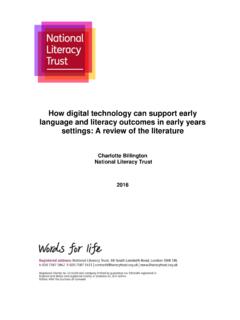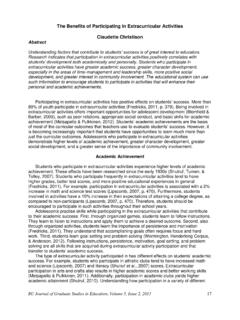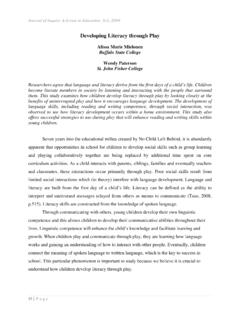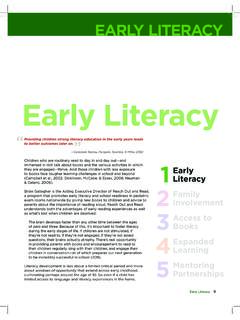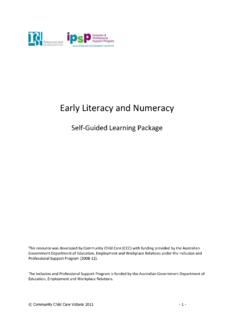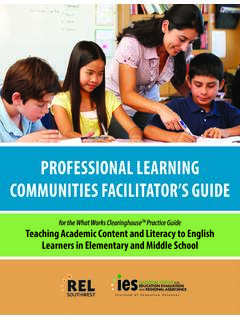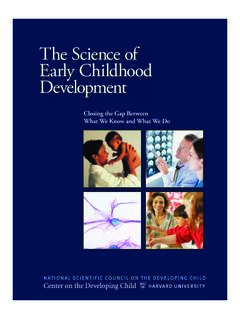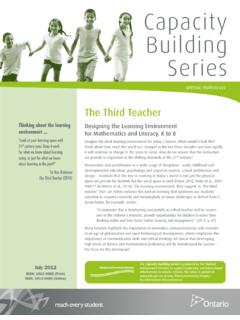Transcription of An introduction to attachment and the implications for ...
1 An introduction to attachment and the implications for Learning and Behaviour Queen's Printer and Controller of Her Majesty's Stationery Office (2014). 1. Before we start . I want all children to have the best possible start in life. Children, such as those who are in care or adopted from care, who have been neglected, or failed to form secure attachments with adults in their early years, exhibit a variety of behaviours at school and as teenagers. If not recognised, it can lead to exclusion, educational underachievement and wasted lives. This module demonstrates a commitment to increasing teachers' awareness of attachment issues and to developing strategies to break this cycle of deprivation. Edward Timpson MP, Minister for Children Every teacher, and every school, should be so aware and so practising, because it is the duty of the public body to adapt to the child, not the other way round.
2 Dr Maggie Atkinson, Children's Commissioner for England 2. Queen's Printer and Controller of Her Majesty's Stationery Office (2014). Background to this training resource These materials have been developed through a partnership between Bath Spa University, Bath and North East Somerset Council, the National College for Teaching and Leadership, a range of third sector organisations, attachment specialists and local schools. The materials are informed by research and based on evidence from classroom practice. At the heart of this training tool is a concern to do our best for all children in school, not solely those who exhibit symptoms of trauma and unmet attachment needs, and a conviction that schools which are truly attachment aware', are those where all children are ready to learn and achieve. Queen's Printer and Controller of Her Majesty's Stationery Office (2014).
3 3. introduction : why attachment matters Most children enjoy life and are successful in school and in relationships. This lasts into adult life. But a significant minority struggle from an early stage and especially in adolescence. These children can be: Unfocussed Disruptive Controlling Withdrawn Destructive These children tend to underachieve in school and are often punished and even excluded. Little that schools do seems to work. Queen's Printer and Controller of Her Majesty's Stationery Office (2014). 4. introduction : why attachment matters As a result, these children may not fulfil their potential as adults , either in employment or relationships Those adults who enjoyed success in school can find these children hard to engage and motivate research shows that a child's ability to form relationships and to learn is shaped by the child's early experiences So, if we can better understand WHY and HOW some children behave the way they do, we can then find ways to help them enjoy and succeed in their education It is a fascinating area of research with major implications for how schools support all children to succeed Why attachment matters video clip Queen's Printer and Controller of Her Majesty's Stationery Office (2014).
4 5. Key learning points about attachment The nature of a child's primary attachments to caregivers lay the foundations for socio- emotional well-being and therefore Educators themselves children's capacity to need to establish an learn attachment -like relationship with their pupils, particularly with challenging and vulnerable pupils, in Secure attachment order to enhance relationships learning opportunities correlate strongly for all with higher academic attainment, better self-regulation and social competence Queen's Printer and Controller of Her Majesty's Stationery Office (2014). 6. Outline of this online training is attachment ? - an introduction to the research on attachment and the neuroscience of attachment do educators need to know about attachment ? - the implications for learning and behaviour can leaders do? - signposts for theory into practice Queen's Printer and Controller of Her Majesty's Stationery Office (2014).
5 7. Section 1. What is attachment ? an introduction to attachment theory and the neuroscience of attachment Queen's Printer and Controller of Her Majesty's Stationery Office (2014). 8. attachment theory in a nutshell The theory of attachment was first proposed by John Bowlby who described it as a lasting psychological connectedness between human beings' (1988). He considered that children needed to develop a secure attachment with their main caregiver in their early years. This theory has been revised to acknowledge that multiple attachments can occur with other adults throughout the lifespan, although early experiences may continue to have an impact. Secure attachments support mental processes that enable the child to regulate emotions, reduce fear, attune to others, have self-understanding and insight, empathy for others and appropriate moral reasoning (Bowlby called these mental representations the internal working model).
6 Insecure attachments, on the other hand, can have unfortunate consequences. If a child cannot rely on an adult to respond to their needs in times of stress, they are unable to learn how to soothe themselves, manage their emotions and engage in reciprocal relationships. A child's initial dependence on others for protection provides the experiences and skills to help a child cope with frustrations, develop self-confidence and pro-social relationships - all qualities necessary to promote positive engagement with learning. research has inextricably linked attachment to school readiness and school success (Commodari 2013, Geddes 2006). attachment theory in a nutshell, Robin Balbernie video clip Queen's Printer and Controller of Her Majesty's Stationery Office (2014). 9. Internal Working Models These are the mind's internalized pictures of the physical and mental experiences of attunement with caregivers.
7 They are established in childhood and are used to inform behaviour in all of the significant relationships in a child's and adult's life. They serve as filters for understanding current and future interactions and are used to help the child evaluate, predict and choose what behaviour to present. They reflect :- Memories of day to day interactions Expectations &. affective Accumulating Adopted experience Behavioural Strategies schemas associated or event scripts with interactions (Rose, Gilbert and McGuire- Actions based on and guided by Sniekus, forthcoming). previous interactions 10. Queen's Printer and Controller of Her Majesty's Stationery Office (2014). attachment theory the key messages Nurturing adult attachments provide children with protective, safe havens and secure bases from which to explore and engage with others and their environment (Bowlby 1988).
8 Early care-giving has a long-lasting impact on development, the ability to learn, capacity to regulate emotions and form satisfying relationships (Siegel 2012). attachment is crucial to children's psychological welfare and forms the basis of personality development and socialisation (Bowlby 1988). Teachers, youth workers and significant adults in a child's life can provide important attachments for children (Bergin and Bergin 2009, Riley 2010). The biological function of attachment is survival; the psychological function is to gain security (Schaffer 2004) 11. Queen's Printer and Controller of Her Majesty's Stationery Office (2014). What are the risk factors affecting attachment and who are the vulnerable groups? The following factors may present a Vulnerable groups may include: risk to the quality of attachment between child and parent: - Children in areas of social and economic deprivation - Children in care - Poverty - Adopted children whose early experiences of trauma continue to - Parental mental health affect their lives difficulties - Disabled children - Children with medical conditions or - Exposure to neglect, domestic illness violence or other forms of abuse - Children who have moved home frequently during the early years - Alcohol/drug taking during forces families pregnancy - Refugees and children who have been traumatised by conflict or loss - Multiple home and school placements BUT.
9 - Premature birth insecure attachments may occur - Abandonment within non-vulnerable children - Family bereavement as well 12. Queen's Printer and Controller of Her Majesty's Stationery Office (2014). attachment types can be seen as self protective behavioural strategies There are 4 identified attachment Current research suggests that: types: Secure I'm ok, you're there for me' At least one third of children have Insecure avoidant It's not ok to be an insecure attachment with at emotional' least one caregiver (Bergin and Bergin 2009). Insecure ambivalent I want comfort but it doesn't help me'. As many as 80% of children Insecure disorganized I'm diagnosed with ADHD have frightened' attachment issues (Clarke et al 2002;. Moss and St-Laurent 2001). The nature of attachment type is a predictor of emotional responses and 98% of children surveyed later social behaviour and resilience experienced one or more trauma Note: Some research uses just two event for one in four this trauma categories of attachment styles resulted in behavioural and/or secure vs.
10 Insecure whilst other emotional disturbance (O'Connor and Russell 2004). research uses a continuum of security in attachment (Bergin and Bergin 2009). Queen's Printer and Controller of Her Majesty's Stationery Office (2014). 13. Secure attachment : Securely attached Insecure Avoidant attachment : Avoidant attached children have experienced sensitive and children have experienced insensitive, intrusive or attuned caregiving. They are able to trust rejecting caregiving. They appear to be and rely on teachers to meet their needs. independent of their teachers and seek to meet As a result they feel confident to form their needs on their own as they have not been able meaningful relationships with others, to to trust or rely on their caregiver. They are task make the most of learning opportunities , orientated, self-reliant and high achieving in some to engage in productive activities, aspects but are generally socially uncomfortable, problem-solve and explore the wider exhibit indifference and avoid close relationships.

